NZXT Havik 120 CPU Cooler Review

It is possible to have it all: compact size, universality, superb efficiency and low noise levels? The new NZXT Havik 120 processor cooler will answer this question for you.
Last summer the North American NZXT Corporation released their first air-cooler – Havik 140. While it was constructively similar to Thermalright Archon, Havik 140 became a serious competitor to the latter mostly due to two 140 mm fans against only one 140 mm fan by Archon and at the expense of a higher noise level. By now Havik 140 has received numerous awards from online and printed media and is proudly bearing the prestige “super-cooler” title.
However, the company decided not to stop at that and has recently announced a new product – NZXT Havik 120:
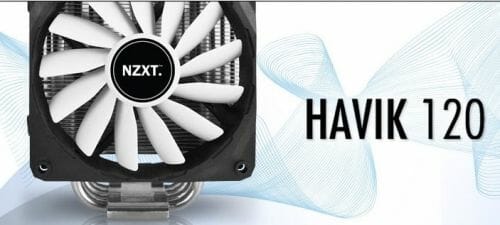
Unlike Havik 140, this junior model is not only smaller in size, but also costs less: it is priced at $5% vs. $70 for Havik 140. However, we still can’t consider this cooler inexpensive and it will have a lot of competitors in this price range. Today we are going to investigate what the new NZXT cooler is capable of, what features and peculiarities it boasts and how efficient and quiet it is at work.
Package and Accessories
Havik 120 cooler comes in a not very large cardboard box with modest black-and-white color scheme:
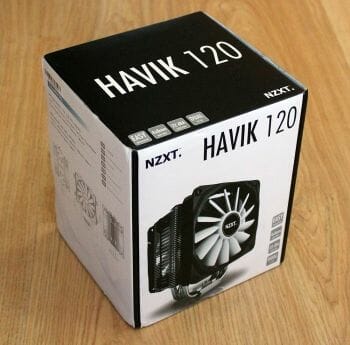
While the design will hardly have the same appealing effect as bright boxes from Thermaltake or Scythe, NZXT packaging is still exceptionally informative:
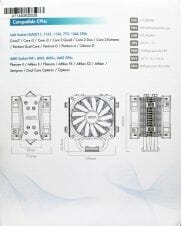
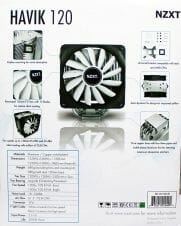

The back and sides of the box list the supported processor types and detailed technical specifications of the cooler, provide brief description of the cooler features and a layout with all dimensions.
Inside the cardboard box we find NZXT Havik 120 sealed inside a polyurethane foam casing protecting the cooler against all transportation mishaps. There is a smaller box with the following accessories at the bottom of the package:

Among them you will find a universal backplate, three retention kits, a retention bracket, silicone mounts for the fans, NZXT thermal paste and installation guide. Overall, everything necessary for fast and easy cooler installation onto any contemporary platform is right there.
NZXT Havik 120 was designed in North America but is manufactured in China. Its MSRP is set at $55 and it comes with 1-year warranty.
Design and Functionality
First, let’s take a closer look at the NZXT Havik 120 heatsink:
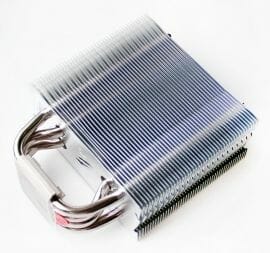
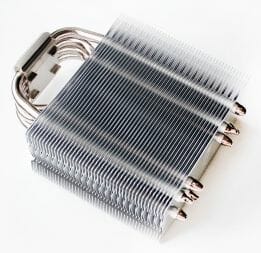
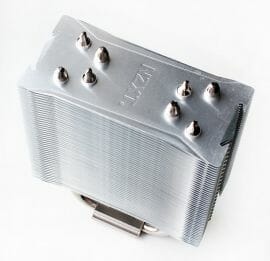
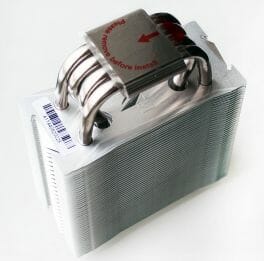
Nothing in its design jumps out as extraordinary: 46 almost rectangular aluminum fins are firmly pressed against four copper nickel-plated heatpipes 8 mm in diameter:
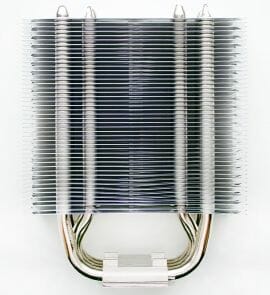
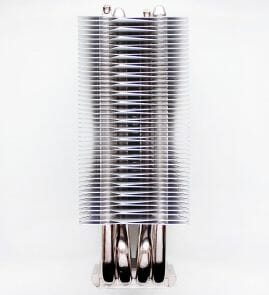
The gaps between the fins are a little less than 2 mm and the fins themselves are 0.5 mm thick. The heatsink dimensions are 160x125x58 mm and its weight is 680 grams. The calculated effective heatsink surface is 6,560 cm2, which is pretty small compared with other tower-cooler available in the today’s market.
The heatpipes pierce the heatsink body symmetrically on both sides and are shifted away from one another:
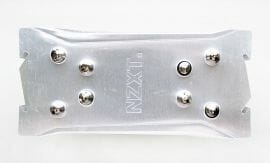

I believe this is how NZXT engineers were trying to ensure that the heat will get distributed evenly over the heatsink surface and also that most heatpipes will end up being in the parts of the heatsink that receive the best airflow. Although to accomplish this, two central heatpipes had to be bent really dramatically right at the base, so they do not have any contact with the lower 4-5 heatsink fins. These fins work only with the side heatpipes:
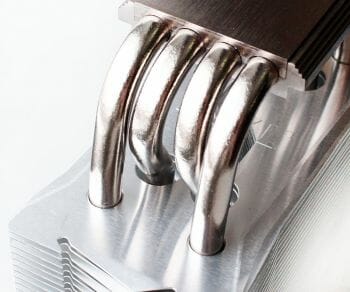
The heatpipes lie inside special grooves in the nickel-plated cooler base and the contact spots are soldered thoroughly.
The base surface looks like it could have been finished better:

However, despite the unappealing looks, you don’t feel the machine marks to the touch at all – the surface is smooth and most importantly – even, and the only reason why we didn’t get a perfect thermal paste imprint was because of the convex CPU heat-spreader:


NZXT Havik 120 can accommodate two 120x120x25 mm fans with uniquely shaped blades:
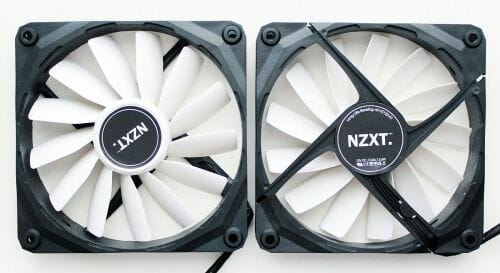
We didn’t find any fan models with this particular blade shape (like a goose feather) among the company’s products. They are probably made exclusively for Havik 120. Judging by their specifications, their maximum rotation speed should be 1500 RPM and if they are connected via a special resistor, then their maximum rotation speed drops to 1200 RPM. The declared level of noise for these specific fans is 22 and 18 dBA, and the airflow – 75.8 and 61.5 CFM, respectively.
The fans use a slide bearing with 30,000 or at least 3.4 years MTBF:
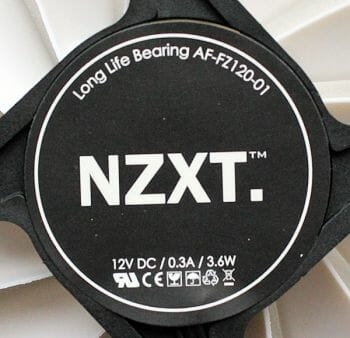
According to the rotor sticker, the maximum power consumption of one such NZXT fan shouldn’t exceed 3.6 W. Our measurements showed that one fan rotating at maximum speed didn’t need more than 2.2 W of power, which means that they are pretty energy-efficient. The startup voltage was equal 4.1 V.
The fans are attached to the heatsink with very soft silicone mounts. These mounts are inserted into the retention holes in the fan frame, then they go in-between the fins and catch on to the slits on the sides of the heatsink:
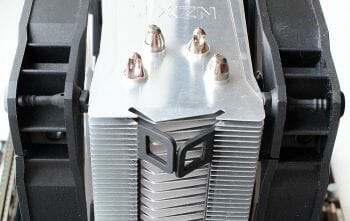
This soft suspension allows to almost completely prevent the vibrations from being transferred through the fan frame into the heatsink thus reducing noise substantially. I have to add that the fans are installed for air intake and exhaust.
Compatibility and Installation
NZXT Havik 120 is compatible with all contemporary platforms including LGA 2011. So today we are going to use this particular platform to study the performance of the new NZXT cooler. You can download the installation instructions for this as well as all other compatible platforms from the company web-site (PDF-file, 8.56 MB).
The installation procedure is overall pretty simple and doesn’t require much effort. First you insert four bushes with double-sided threading into the retention holes in the CPU socket and fasten retention steel panels with them:
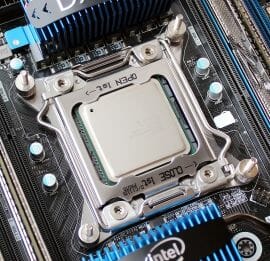
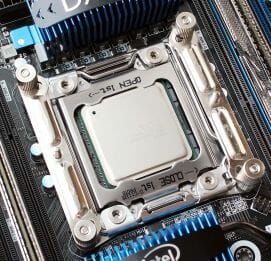
After that you apply a thin and even layer of thermal paste onto the CPU heat-spreader, place the heatsink on top and attach it firmly to the steel panels using a retention bracket with spring-screws:
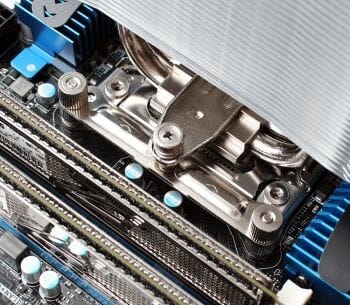
It is more convenient to install just the heatsink without the fans and attach fans afterwards. Otherwise, you won’t be able to reach the screws:


The distance between the lowest heatsink fin and the mainboard PCB is 54 mm and even though the fans go about 7 mm below that, they do not block access to the nearest memory DIMM slots, so that you can even use currently very popular modules with tall heat-spreaders without any problems.
This is what NZXT Havik 120 looks like inside the system case:
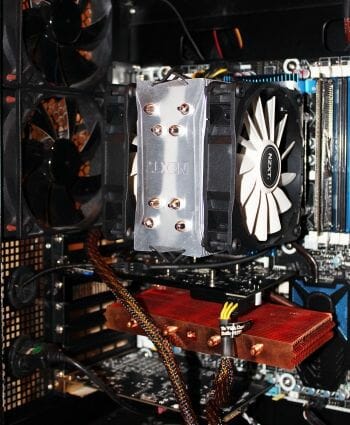
The last but not the least, you connect both fans to a short Y-splitter cable and then to the corresponding mainboard connector, and you are ready to rock and roll!
Technical Specifications and Recommended Pricing
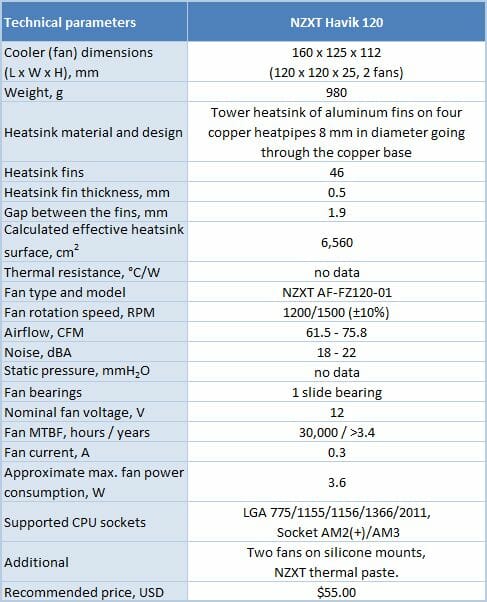
Testbed Configuration and Testing Methodology
We tested all coolers inside a closed system case with the following configuration:
- Mainboard: Intel Siler DX79SI (Intel X79 Express, LGA 2011, BIOS 0380 from 11/28/2011);
- CPU: Intel Core i7-3960X Extreme Edition, 3.3 GHz, 1.2 V, 6 x 256 KB L2, 15 MB L3 (Sandy Bridge-E, C1, 32 nm);
- Thermal interface: ARCTIC MX-4;
- Graphics card: Asus Radeon HD 6770 DirectCU Silent (EAH6770 DCSL/2DI/1GD5) GDDR5 128 bit, 850/4000 MHz (with a passive heatsink from the DeepCool V4000 VGA cooler);
- Memory: DDR3 3 x 2 GB OCZ Platinum Low-Voltage Triple Channel (Spec: 1600MHz / 7-7-7-24 / 1.65 V);
- System drive: Crucial m4 256 GB SSD (SATA-III,CT256M4SSD2, BIOS v0009);
- Drive for programs and games: Western Digital VelociRaptor (300GB, SATA-II, 10000 RPM, 16MB cache, NCQ) inside Scythe Quiet Drive 3.5” HDD silencer and cooler;
- Backup drive: Samsung Ecogreen F4 HD204UI (SATA-II, 2 TB, 5400 RPM, 32 MB, NCQ);
- System case: Antec Twelve Hundred (front panel: three Noiseblocker NB-Multiframe S-Series MF12-S2 fans at 1020 RPM; back panel: two Noiseblocker NB-BlackSilent PRO PL-1 fans at 1020 RPM; top panel: standard 200 mm fan at 400 RPM);
- Control and monitoring panel: Zalman ZM-MFC3;
- Power supply: Xigmatek “No Rules Power” NRP-HC1501 1500 W (with a default 140 mm fan).
For the primary tests and summary diagrams we overclocked our six-core processor with the clock generator frequency set at 125 MHz, the multiplier set at 35x and “Load-Line Calibration” enabled to 4.375 GHz. The nominal processor Vcore was increased to 1.385 V in the mainboard BIOS. After that we tested the new cooler at even higher frequency and voltage settings. Turbo Boost was disabled during this test session, and Hyper-Threading technology was enabled to increase the heat dissipation. The memory voltage was at 1.65 V and its frequency was 1.666 GHz with 8-8-8-16_1T timings. All other parameters available in the mainboard BIOS and related to CPU or memory overclocking remained unchanged.
All tests were performed under Windows 7 Ultimate x64 SP1 operating system. We used the following software during our test session:
- LinX AVX Edition version 0.6.4 – to load the processor (memory – 4500 MB, Problem Size – 24234, two 11-minute cycles);
- Real Temp GT 3.66 – to monitor the processor core temperatures;
- Intel Extreme Tuning Utility version 3.0 – for monitoring and visual control of all system parameters during overclocking.
So, the complete screenshot during the test session looks as follows:
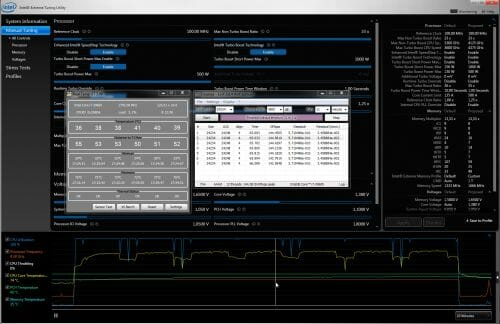
The CPU was loaded with two consecutive LinX test runs with the settings as indicated above. The stabilization period for the CPU temperature between the two test cycles was about 8-10 minutes. We took the maximum temperature of the hottest CPU core for the results charts. Moreover, we will also provide a table with the temperature readings for all cores including their average values. The ambient temperature was checked next to the system case with an electronic thermometer with 0.1 °C precision that allows hourly monitoring of the temperature changes over the past 6 hours. The room temperature during our test session varied between 24.0-24.5°C.
The noise level of each cooler was measured between 1:00 and 3:00 AM in a closed room about 20 m2 big using CENTER-321 electronic noise meter. The noise level for each cooler was tested outside the system case when the only noise sources in the lab were the cooler and its fan. The noise meter was installed on a tripod and was always at a 150 mm distance from the cooler fan rotor. The tested cooling systems were placed at the edge of the desk on a sheet of polyurethane foam. The lowest noise reading our noise meter device can register is 29.8 dBA and the subjectively comfortable noise level in these testing conditions was around 36 dBA (do not mix it up with low noise level). The fan(s) rotation speed was adjusted in the entire supported range using our in-house controller by changing the voltage with 0.5 V increment:

WE are going to compare NZXT Havik 120 against a cheaper, but very worthy cooler – Thermalright HR-02 Macho ($39.95) equipped with one Thermalright TY-140 fan. Besides the default fans, we also tested Havik 120 with two Thermalright TR-FDB-2000 fans in 800-1600 RPM speed range with 200 RPM increments and at maximum speed of 2000 RPM. The rotation speed of all fans was controlled using the same special controller with ±10 RPM precision.
Well, it is time to check out the obtained results.
Performance
Cooling Efficiency Tests
The results of our cooling efficiency tests are summed up in the diagram and table below:
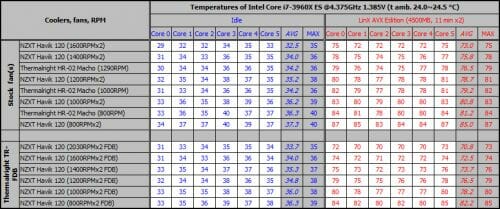
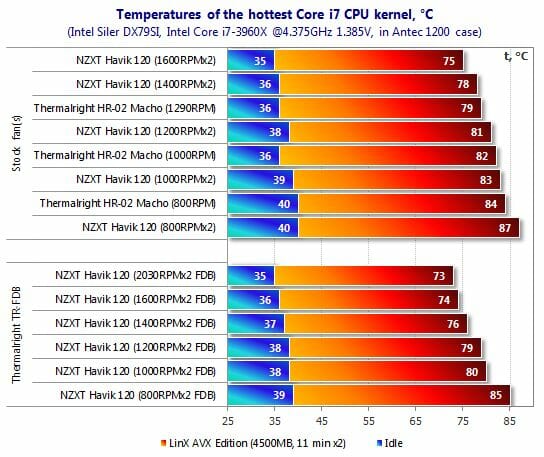
When tested with two default fans NZXT Havik 120 proved very efficient and managed to cope with an overclocked six-core processor even at 800 RPM fan speed. At the same time, HR-02 Macho cooler tested with one default fan at the same 800 RPM proved to be 3°C more efficient than Havik 120 under peak load. At 1000 RPM this difference is only 1°C, and at maximum fan speed for both coolers Thermalright’s product loses 4°C to the new NZXT cooler. Of course, at this point we do not take into account the acoustics, but we will discuss it in just a few paragraphs.
We can clearly see that the cooling efficiency of NZXT Havik 120 depends a lot on the rotation speeds of its both fans: the temperature difference between the lowest speed of 800 RPM and maximum speed of 1600 RPM is 12°C, and within this range it changes by 2-4°C in every 200 RPM increment. Besides, I would like to draw your attention to the fact that Havik 120 cooler becomes even more efficient once we replace the default fans with Thermalright TR-FDB-2000. For example at 800 RPM the improvement from the default fans is 2°C, at 1000 RPM – 3°C, at 1200 and 1400 RPM – 2°C, and at the maximum 1600 RPM the temperature is 1°C lower with alternative fans. The results obtained with these two alternative fans show that NZXT’s original fans are probably not the best match for the new Havik 120.
Despite this fact, the maximum CPU overclocking experiment was performed with the default fans at their maximum speed. As we found out, the new NZXT cooler can ensure stability of the overclocked 6-core processors at 4.5 GHz with the Vcore set at 1.405 V and peak temperature of the hottest core at 79°C:
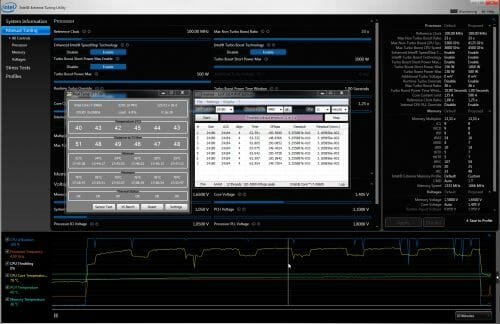
We couldn’t push NZXT Havik 120 any further, but even this result is quite good already.
Now let’s add the results of the new NZXT Havik 120 cooler to our database diagram and table, where all coolers are entered in their default configurations. We will add the results in quiet mode (2×800 RPM) and at maximum speed of both fans (2×1600 RPM) when the CPU was overclocked to 4.375 GHz at 1.385 V core voltage:

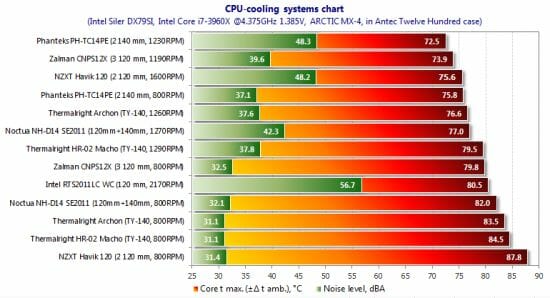
If we disregard the noise at this point, we can conclude that at 1600 RPM of both fans the new Havik 120 is as efficient as Phanteks PH-TC14PE with two fans at 800 RPM or Thermalright Archon with one fan at 1260 RPM. Of course, both super-coolers work much quieter in this case. As for the quiet mode, NZXT Havik 120 was the last one here having lost a little over 3°C to its closest competitor – Thermalright HR-02 Macho.
We would also like to add Havik 120 to the new cooling systems rating according to the maximum CPU overclocking that they allow. All coolers are also entered in their default configurations only:

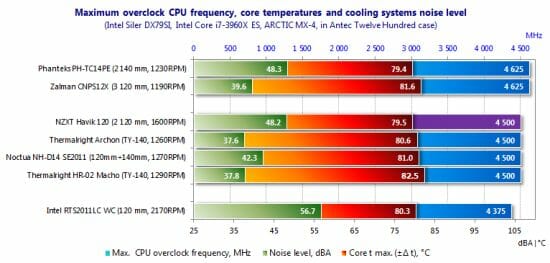
NZXT Havik 120 also looks pretty good here, but only at relatively high rotation speed of both its fans and therefore higher level of generated noise. At lower fan speeds the new cooler couldn’t cope with a six-core processor overclocked to 4.5 GHz. Despite this fact, we have to admit that NZXT Havik 120 did very well overall.
The only thing left to address at this point is the acoustic performance of the tested cooling products.
Acoustic Performance
We measured the noise from our testing participants in the entire supported speed range of their fans following the methodology described above. The results are summed up on the following graph:
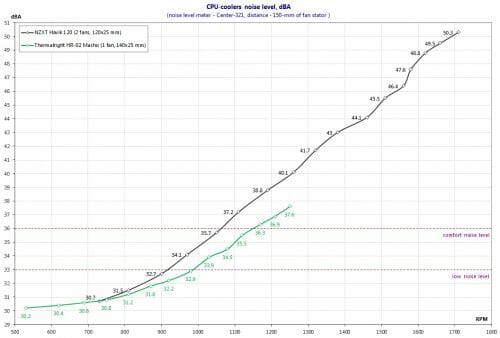
As we see, two NZXT fans on Havik 120 are noisier than one 140 mm fan in Thermalright HR-02 Macho, but the difference in acoustic performance is insignificant. Havik 120 remains acoustically comfortable up to 1050 RPM and quiet at up to 920 RPM, while Macho remains acoustically comfortable at up to 1150 RPM and quiet at up to 980 RPM. Note that soft fan suspension and perfectly-balanced impellers they produce no parasitic noises, crackling or vibrations, which makes the noise quite acceptable even beyond the subjective acoustic comfort zone.
Conclusion
In fact, the only drawback the new NZXT Havik 120 has is its high price. Today 55 dollars will buy you not only a more efficient but also a quieter cooler, and we had one of them competing against the newcomer in our today’s test session. If Havik 120 cost $10 less (better $15 less), it would become very attractive solution for overclockers, as high price is its only drawback and everything else about it is great.
The new NZXT cooler is completely universal, has a simple and reliable high-pressure retention and doesn’t interfere with the tall heatsinks on memory modules or voltage regulator components. At the same time, NZXT Havik 120 offers great cooling efficiency and is capable of coping with (not extremely) overclocked six-core processors at minimal rotation speed of its two default fans. Some improvements of the base finish and, most likely, use of alternative fans with classical blades could make this cooler even better. However, in our opinion, its market success will primarily depend on its price.